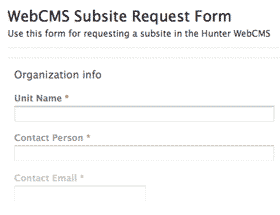What is the workflow process?
Your subsite's workflow process determines how your content is created, edited, reviewed and published. By delegating each responsibility to a particular person or group, you can maximize the productivity and efficiency of your department's web team, without having to schedule regular meetings or use email to manage your web documents.
A complete workflow system is built into the WebCMS. All content goes through "states" as it is created, edited, reviewed and published. Changing the "state" of an object also changes the actions that a particular user can take, dependent upon the user's role(s). This means that one user's capabilities will differ from another's, and can change as a content item goes through the workflow process. Note: If two people have differing capabilities when they believe their role(s) are the same, they should contact their subsite's staff manager.
The roles set for users by the staff manager should be part of an organizational process to ensure proper editing control and oversight of public web content. Having several people writing, editing and reviewing content means more frequent updates, fewer errors, and greater continuity when people are absent.
The principle behind having more than one person participating in editing, reviewing and publishing content is so that incorrect or poorly-worded content can be revised before publication. Roles can overlap, so that as content is handed off for review or publishing, the next person in line can edit the content as needed. All content review and spell-checking should take place before the item is made publicly visible.
When discussing workflow in the WebCMS, it helps to refer to users by titles rather than the particular role(s) they've been assigned. For instance, a publisher might be someone with the "publish content" role, a reviewer might be someone with the "review content" and "edit content" roles, a site planner might be someone with the "plan/design site" role, and an author might be someone with the "add content" and "edit content" roles.
Example: Let's say that a small department or office has a director, an administrator, and several assistants. The administrator might be assigned as the staff manager, while the director might wish to be added as a publisher so that he or she could control what is published without doing any actual writing. The administrator might choose to also be a reviewer and site planner so that they could submit content for publishing and rearrange the site's contents. The assistants could be considered authors, and given the responsibility to create new pages at the request of the director or administrator.
Basic WebCMS Workflow
When an object such as a page or folder is first created, it will be in the "working draft" state. Objects in this state can be edited, copied or deleted by any content-related user model (author, reviewer, site planner, publisher). Items in the "working draft" state are very easy to edit or delete.
Once a new object is created and the author is satisfied with their content, a "working draft" item can be submitted for review.
A reviewer may then review the content on its way to publication. The reviewer has the option to edit, move or delete content in the "working draft" or "pending review" states. The reviewer may then choose to submit the item for external publication or publish the item internally.
The publisher decides if an object is ready for public view, and can edit or delete content in the "pending external publication" state. Once a publisher changes an item's state to "externally published", it can no longer be directly edited or deleted.
In order to edit an item that has been "externally published", the item must be versioned using the check-out/check-in process to create an internal copy of the public item to be edited. Authors, reviewers and publishers can "check out" content for revision; however, the item must be "checked in" by a publisher. This may require the item to go through the workflow process again.
Externally published content can only be deleted by a publisher. The publisher must first mark the item as "old" before it can be deleted. This is to ensure that public-facing content is not accidentally or unintentionally removed.
The below diagram may help you visualize the workflow process and how the various states relate to each other. (Click on the image to enlarge it.)







